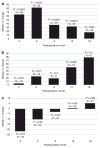Increased PTH and 1.25(OH)(2)D levels associated with increased markers of bone turnover following bariatric surgery
- PMID: 21617641
- PMCID: PMC3411200
- DOI: 10.1038/oby.2011.133
Increased PTH and 1.25(OH)(2)D levels associated with increased markers of bone turnover following bariatric surgery
Abstract
The objective of this study was to characterize changes in metabolic bone parameters following bariatric surgery. Seventy-three obese adult patients who underwent either gastric banding (GB), Roux-en-Y gastric bypass (RYGB), or biliopancreatic diversion with duodenal switch (BPD/DS) were followed prospectively for 18 months postoperatively. Changes in the calcium-vitamin D axis (25-hydroxyvitamin D (25OHD), 1,25-dihydroxyvitamin D (1,25(OH)(2)D), calcium, parathyroid hormone (PTH)), markers of bone formation (osteocalcin, bone-specific alkaline phosphatase) and resorption (urinary N-telopeptide (NTx)), as well as bone mineral density (BMD) were assessed at 3-month intervals during this time period. Bariatric surgery resulted in significant and progressive weight loss over 18 months. With supplementation, 25OHD levels increased 65.3% (P < 0.0001) by 3 months, but leveled off and decreased <30 ng/ml by 18 months. PTH initially decreased 21.4% (P = 0.01) at 3 months, but later approached presurgery levels. 1,25(OH)(2)D increased significantly starting at month 12 (50.3% increase from baseline, P = 0.008), and was positively associated with PTH (r = 0.82, P = 0.0001). When stratified by surgery type, median PTH and 1,25(OH)(2)D levels were higher following combined restrictive and malabsorptive operations (RYGB and BPD/DS) compared to GB. Bone formation/resorption markers were increased by 3 months (P < 0.05) and remained elevated through 18 months. Radial BMD decreased 3.5% by month 18, but this change was not significant (P = 0.23). Our findings show that after transient improvement, preoperative vitamin D insufficiency and secondary hyperparathyroidism persisted following surgery despite supplementation. Postoperative secondary hyperparathyroidism was associated with increased 1,25(OH)(2)D levels and increased bone turnover markers.
Conflict of interest statement
The authors declared no conflict of interest.
Figures


References
-
- Ogden CL, Carroll MD, Curtin LR, et al. Prevalence of overweight and obesity in the United States, 1999–2004. JAMA. 2006;295:1549–1555. - PubMed
-
- Eckel RH, Krauss RM. American Heart Association call to action: obesity as a major risk factor for coronary heart disease. AHA Nutrition Committee Circulation. 1998;97:2099–2100. - PubMed
-
- Mokdad AH, Ford ES, Bowman BA, et al. Prevalence of obesity, diabetes, and obesity-related health risk factors, 2001. JAMA. 2003;289:76–79. - PubMed
-
- Buchwald H, Oien DM. Metabolic/bariatric surgery Worldwide 2008. Obes Surg. 2009;19:1605–1611. - PubMed
Publication types
MeSH terms
Substances
Grants and funding
LinkOut - more resources
Full Text Sources
Medical
Research Materials

